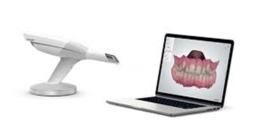Oral Health Quantitative Outcomes for Physiologic and Non-Physiologic Tooth Displacement
TECHNOLOGY NUMBER: 2019-169

OVERVIEW
A means to provide reliable quantitative assessment of tooth displacement- Software that measures and evaluates 3-D images from intra-oral scanners
- Reproducible accuracy over consecutive visits as well as between different users
BACKGROUND
Dentists have commonly relied on impression techniques and a sophisticated dental laboratory to generate the three-dimensional models of dental tissues. Intra-oral (IO) scanners have been developed to overcome these requirements. Intra-oral scanners work by projecting a light source onto the dental arches and collecting images that are then processed by the scanning software, generating cloud points, which are triangulated to create a 3D surface model. Oral scanners help create 3D models of teeth, denture bridges, and other implants, plan surgical procedures, store patient data, design oral healthcare items, and in education and training.
Up to this point the use of IO scanners to determine tooth mobility has been limited, and those measures are more commonly calculated by applying pressure to move the tooth backwards and forwards or by visual inspection. Slight tooth mobility has been observed in healthy teeth, however mobility beyond a physiologic limit diagnoses periodontal disease, estimates prognosis, and is a useful marker to measure the success or failure of periodontal treatment. A need exists to develop a method to more accurately and reproducibly document tooth displacement that results from trauma from occlusion, periodontitis, cysts, or tumors.
INNOVATION
Researchers at the University of Michigan have invented a means to provide reliable quantitative assessment of tooth displacement that measures mobility by comparing reference points of the moving tooth and non-moving tissues in the oral cavity. The software evaluates three-dimensional images obtained by IO scanners which capture tooth positions in physiological and non-physiological circumstances. The invention is a non-invasive technique that collects data of tooth mobility without the need to intervene with invasive analog tools, such as periodontal or exploratory probes, minimizing the impact of the operator technique and experience on the outcome measure. Data evaluation shows reproducible accuracy of measures between the same user over consecutive visits as well as between different users. The overall displacement of the tooth yields a quantitative outcome to be used for diagnosis, planning, assessing tooth prognosis, determining the need for intervention, communicating results between different labs, and evaluating patients' progress with and without treatment. The details of these changes in tooth mobility can also be used to track orthodontic adjustments over time. The approach can be utilized in any type of dental clinic.